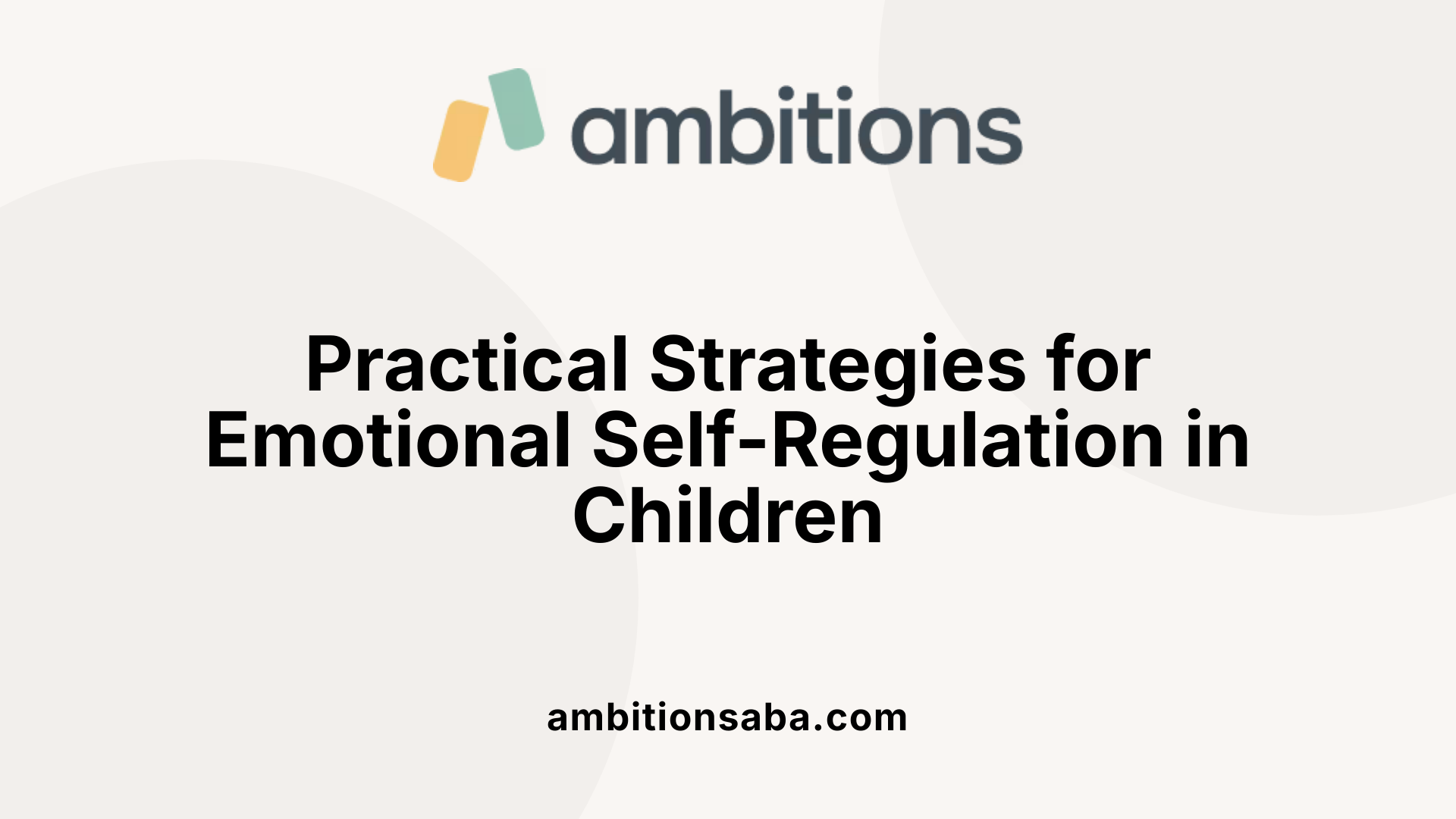Helping Children Understand and Express Emotions
Emotional awareness and expression are vital skills that contribute to children’s social success and mental well-being. For children with autism spectrum disorder (ASD), understanding and labeling emotions can be particularly challenging, impacting their interactions and adaptive functioning. This article explores practical methods and therapies that help children with autism recognize, label, and express their feelings effectively, fostering healthier relationships and emotional regulation.
Everyday Interactions as Opportunities for Emotional Learning

How can everyday interactions be used to teach children about emotions?
Using everyday interactions, such as reading books or visiting friends, creates natural opportunities to label and discuss emotions.
During a story, caregivers can point out how a character looks or feels, saying things like, "Look, she seems happy because she got a new toy," or "He looks worried about the storm." When visiting friends, adults might comment on facial expressions or body language, labeling emotions they observe.
This practice helps children connect emotion words like happy, sad, or angry with real facial expressions and situations. It makes emotional learning more meaningful and easier to remember.
These real-life examples also help children with autism learn to recognize emotions in everyday contexts, improving their social understanding and ability to relate to others.
Through repeated exposure in various settings, children begin to generalize emotional language beyond specific lessons, which can enhance emotional communication and reduce frustration.
By integrating emotional vocabulary naturally into daily routines, caregivers build a foundation for emotional awareness that is practical and effective.
Visual and Sensory Tools to Enhance Emotional Recognition

What tools help children recognize and understand emotions?
Children, especially those with autism, can benefit greatly from visual and sensory tools designed to aid emotional recognition. Emotion cards and social stories serve as straightforward, interactive methods to label and explain different emotions. These tools encourage children to connect facial expressions or situations with corresponding feelings.
Comic strips also play a valuable role by illustrating emotional scenarios in an engaging and relatable way. Combining visuals with narratives helps children understand not just the emotion but also the context in which it appears.
Furthermore, visual ladders and thermometers featuring emojis offer a clear representation of emotional intensity. These aids depict a range from mild to strong feelings, helping children discern subtle differences in how emotions can vary in strength. By associating these scales with personal experiences, children can better articulate and manage their feelings.
Overall, these visual and sensory supports translate complex emotional concepts into accessible formats, fostering improved communication and emotional awareness.
Connecting Body Sensations with Emotions

Identifying physiological signs of emotions
Children, especially those with autism, often struggle to recognize and label their feelings. One effective strategy is to guide them in noticing physical signs their body gives when experiencing emotions. For example, many children describe a "funny feeling" in their stomach when they feel worried or anxious. These bodily cues act as concrete indicators, revealing their emotional state in a way that words alone may not convey.
Describing sensations to improve emotional awareness
Encouraging children to articulate these bodily sensations—not just the emotions themselves—builds their emotional vocabulary and awareness. When a child learns to say they feel "tightness in the chest" when scared or "warmth in the face" when embarrassed, they develop a more nuanced understanding of their feelings. This practice strengthens the mind-body connection, making abstract emotions easier to comprehend and communicate.
Using body awareness to regulate feelings
Recognizing physiological signals also empowers children to manage emotions proactively. By noticing sensations such as increased heart rate, muscle tension, or stomach discomfort, they can pause and apply calming techniques like deep breathing or sensory activities. This early detection supports emotional regulation, helping reduce distress and promoting mental well-being.
How can identifying body sensations aid in emotional understanding?
Focusing on bodily sensations provides tangible clues that deepen emotional comprehension. It bridges the gap between intangible feelings and physical experiences, allowing children to recognize what they feel sooner and respond more effectively. This awareness is particularly significant for children with autism, enhancing their ability to interpret emotions and fostering better social interactions.
Through everyday conversations and guided activities, adults can help children connect emotions to their bodies, building a foundation for emotional health and self-regulation.
Teaching the Influence of Thoughts on Feelings

Cognitive Aspects of Emotion
Understanding how thoughts impact emotions is crucial for children, especially those with autism. Teaching that feelings aren’t just spontaneous but often arise from what we think helps build a bridge between cognition and emotion.
Explaining How Perception Affects Emotion
Children learn to recognize that their interpretation of events shapes their emotional reactions. For example, thinking a dog is playful leads to feelings of happiness, while seeing the dog as dangerous triggers fear. This perspective encourages children to reconsider fearful or negative thoughts.
Supporting Acceptance of Emotions Through Understanding Thoughts
When children grasp that feelings come from thoughts, they can better accept their emotions instead of feeling overwhelmed or confused. This understanding fosters emotional regulation by enabling children to pause, reflect, and potentially reframe their thoughts. Such cognitive flexibility is especially helpful for managing strong feelings.
Teaching children this connection empowers them with a meaningful tool to understand and manage their emotional world more effectively, improving social interactions and personal well-being.
Supporting Emotional Regulation with Behavioral Techniques

How can children be supported to manage their emotions?
Children benefit from learning to notice and name their emotions as a first step toward emotional regulation. This involves helping them identify what they are feeling, such as anxiety or anger, so they can better understand and communicate their experiences.
Encouraging children to pause before reacting allows them a moment to process the emotion instead of reacting impulsively. This pause is crucial in developing self-control and avoiding disruptive behaviors.
Several strategies can aid in calming down after identifying an emotion:
- Relaxation exercises: Techniques like deep breathing or guided imagery help reduce physiological arousal.
- Sensory stimulation: Using tactile or proprioceptive input, such as squeezing a stress ball or playing with textured toys, can provide calming effects.
- Physical activities: Movement-based activities like jumping or stretching release tension and promote emotional balance.
These behavioral techniques are effective in building emotional self-regulation skills, especially for children with autism who often face challenges managing intense feelings. Consistent use of these strategies supports better social interactions and reduces the likelihood of behavioral outbursts.
Applied Behavior Analysis (ABA) Therapy: Foundations and Application
What is applied behavior analysis (ABA) therapy, and how is it used in treating autism?
Applied Behavior Analysis (ABA) therapy is a scientifically supported method that focuses on understanding and modifying behaviors to improve socially important skills in individuals with autism. It is grounded in behavioral principles that emphasize observing and measuring behaviors, followed by applying positive reinforcement to encourage desirable actions and reduce challenging behaviors.
Definition and principles of ABA
ABA therapy is built on analyzing behavior within specific contexts and learning how environmental factors influence actions. It aims to identify triggers for behaviors and systematically teach new skills or replace maladaptive behaviors with functional alternatives. Reinforcement strategies, especially positive reinforcement, are used extensively to motivate and shape behaviors over time.
Use of positive reinforcement and individualized plans
One cornerstone of ABA is positive reinforcement, where preferred rewards encourage repetition of targeted behaviors. Therapists develop individualized intervention plans tailored to each child's unique needs, strengths, and goals. These plans may involve structured routines, clear expectations, and visual supports to make learning consistent and approachable.
Methods like modeling, prompting, and data tracking
ABA employs a variety of evidence-based methods, including modeling appropriate behaviors, prompting to guide responses, and behavior chaining to build complex skills step-by-step. Continuous data collection and analysis allow for monitoring progress and adjusting techniques to maximize effectiveness.
When delivered early and consistently by trained professionals, ABA therapy helps children with autism improve communication, social interactions, daily living skills, and emotional regulation. This comprehensive approach supports children in achieving greater independence and better quality of life.
Professional Providers and Collaborative Care in ABA Therapy
Who typically provides ABA therapy services?
ABA therapy is delivered by professionals extensively trained in applied behavior analysis, including Board Certified Behavior Analysts (BCBAs), assistant behavior analysts, and licensed behavior therapists. These providers usually have advanced degrees in psychology, education, or related areas, coupled with comprehensive supervised experience before earning certification through the Behavior Analyst Certification Board (BACB). Clinics and companies offering ABA often employ teams of these experts.
What qualifications do ABA therapists have?
ABA therapists hold credentials like the BCBA or Board Certified Assistant Behavior Analyst (BCaBA), which require passing rigorous exams and maintaining ongoing education. These certifications confirm that therapists possess a thorough understanding of behavioral principles and can apply evidence-based interventions. Training covers conducting Functional Behavior Assessments (FBAs), designing individualized behavior plans, and monitoring progress.
What role do boards and certifications play?
Certification bodies such as the BACB oversee the credentialing process, ensuring uniform standards of competency and ethics among practitioners. These boards set professional guidelines and promote continued professional development to keep providers up-to-date with current research and best practices. This regulatory framework safeguards clients by ensuring quality, accountability, and efficacy in ABA therapy services.
How does collaboration enhance ABA therapy?
Collaborative approaches are essential for maximizing outcomes in ABA therapy. Providers work closely with families, educators, speech therapists, occupational therapists, and healthcare professionals to create integrated support systems. Parent training programs empower caregivers to apply ABA techniques consistently at home, reinforcing skill acquisition. Multidisciplinary teamwork facilitates holistic care addressing communication, social skills, emotional regulation, and daily living skills.
| Provider Type | Required Credentials | Role and Responsibilities |
|---|---|---|
| Board Certified Behavior Analyst (BCBA) | Master's degree, BACB certification | Develops and oversees ABA programs, conducts assessments, trains others |
| Assistant Behavior Analyst (BCaBA) | Bachelor's or master's, BACB certification | Implements ABA programs under supervision, collects data |
| Licensed Behavior Therapist | Varies by region | Delivers direct ABA therapy to clients |
By ensuring ABA therapists are highly trained and fostering collaborative care that includes families and other specialists, therapy for children with autism can be both effective and responsive to individual needs.
Benefits and Ethical Considerations of ABA Therapy
What are the benefits and potential limitations of ABA therapy for individuals with autism?
Applied Behavior Analysis (ABA) therapy has been extensively researched and offers significant benefits for individuals with autism. It effectively improves communication skills, social interaction, and reduces challenging behaviors by using scientifically proven techniques grounded in behavioral theory. ABA interventions are tailored to each child’s unique needs and often begin early in life, tapping into critical periods of brain plasticity for greater long-term impact.
One of the major advantages of ABA is its strong emphasis on positive reinforcement, which encourages desired behaviors through rewards and play-based learning. These strategies not only promote skill acquisition but also enhance motivation and engagement. For instance, ABA-based therapies such as the Early Intensive Behavioral Intervention (EIBI) and the Early Start Denver Model (ESDM) adapt to developmental stages, offering age-appropriate support.
Despite its effectiveness, ABA therapy has faced criticism, with concerns around its perceived rigidity and the past use of punitive measures. However, modern ethical standards strictly prohibit aversive techniques and prioritize person-centered approaches that respect individual differences, including neurodiversity. These approaches focus on compassionate support, encouraging self-expression and autonomy while working collaboratively with families.
Ultimately, the benefits of ABA therapy in enhancing functional skills and reducing harmful behaviors are well-documented. Success depends on emphasizing ethical, individualized interventions that honor each person's preferences and developmental goals while promoting their emotional and social well-being.
Play and Occupational Therapy to Support Emotional Expression
Types of play therapy and their goals
Play therapy encompasses various methods tailored to support children with autism in expressing emotions and developing social skills. Common types include sensory integration, child-centered, floor time, and art-play therapy. Each approach is evidence-based, focusing on building trust, enhancing communication, and fostering emotional regulation. The overarching goal is to help children express feelings through activities of their choice, transforming difficult behaviors into safe expressive outlets using toys or creative interactions.
Combining play with sensory integration
Occupational therapy often combines sensory integration with play therapy to meet the unique sensory processing and developmental needs of children with autism. This combined approach supports emotional and social growth by stimulating neural connections and promoting neuroplasticity. Sensory activities alongside play enhance the child's ability to manage emotions and participate more fully in social and communicative exchanges.
Enhancing social interaction, communication, and regulation
Play therapy plays a crucial role in addressing common challenges in autism, such as limited symbolic play and joint attention, and a preference for repetitive or solitary activities. By engaging children in play-based techniques, therapists create opportunities to improve social interaction, facilitate communication development, and support emotional regulation. This hands-on, interest-driven engagement helps children build essential skills in a comfortable, supportive environment, boosting their ability to relate to others and manage emotions effectively.
Fostering Emotional Language and Expression for Lifelong Benefits
Helping children with autism label and express their emotions is essential for their social development, mental health, and daily functioning. Using everyday interactions, visual aids, body awareness, and cognitive strategies provides foundational emotional understanding. Evidence-based behavioral methods, particularly applied behavior analysis, offer systematic, individualized approaches to teach emotional vocabulary and regulation skills effectively. Complementary interventions such as play and occupational therapy enrich emotional expression by engaging children through meaningful, motivating activities. Early, collaborative, and compassionate support from trained professionals and family involvement maximizes positive outcomes, empowering children to navigate social relationships and life challenges with greater confidence and resilience.
References
- Emotions: autistic children & teens
- Play therapy in children with autism: Its role, implications, and ...
- Autism Therapy Types & Interventions
- Behaviour Therapy: 5 Proven Ways To Boost Success
- A teaching procedure to help children with Autism ...
- How to Become an ABA Therapist - School of Education
- Qualifications Needed to Receive ABA Therapy



